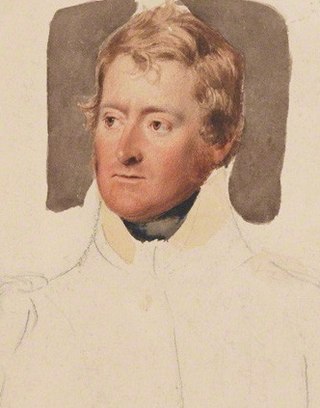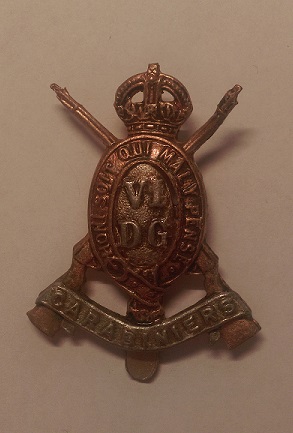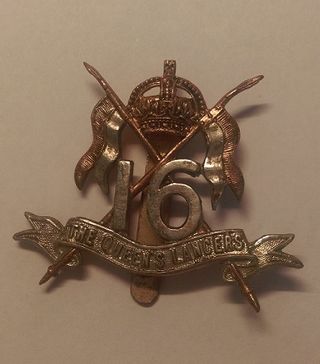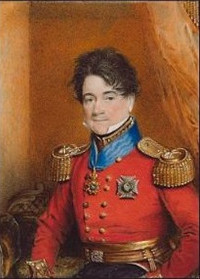
Field Marshal Sir Robert Rich, 4th Baronet was a British cavalry officer. As a junior officer he fought at the Battle of Schellenberg and at the Battle of Blenheim during the War of the Spanish Succession. He was then asked to raise a regiment to combat the threat from the Jacobite rising of 1715. He also served with the Pragmatic Army under the Earl of Stair at the Battle of Dettingen during the War of the Austrian Succession. As a Member of Parliament he represented three different constituencies but never attained political office.

Field Marshal Hugh Gough, 1st Viscount Gough, was an Irish officer of the British Army. After serving as a junior officer at the seizure of the Cape of Good Hope during the French Revolutionary Wars, Gough commanded the 2nd Battalion of the 87th Regiment of Foot during the Peninsular War. After serving as commander-in-chief of the British forces in China during the First Opium War, he became Commander-in-Chief, India and led the British forces in action against the Marathas defeating them decisively at the conclusion of the Gwalior campaign and then commanded the troops that defeated the Sikhs during both the First Anglo-Sikh War and the Second Anglo-Sikh War.

The 5th Royal Irish Lancers was a cavalry regiment of the British Army. It saw service for three centuries, including the First World War. It amalgamated with the 16th The Queen's Lancers to become the 16th/5th Lancers in 1922.

The 9th Queen's Royal Lancers was a cavalry regiment of the British Army, first raised in 1715. It saw service for three centuries, including the First and Second World Wars. The regiment survived the immediate post-war reduction in forces, but was amalgamated with the 12th Royal Lancers to form the 9th/12th Royal Lancers in 1960.

Major General Hon. Sir Frederick Cavendish Ponsonby was an Anglo-Irish military officer.

The Carabiniers (6th Dragoon Guards) was a cavalry regiment of the British Army. It was formed in 1685 as the Lord Lumley's Regiment of Horse. It was renamed as His Majesty's 1st Regiment of Carabiniers in 1740, the 3rd Regiment of Horse (Carabiniers) in 1756 and the 6th Regiment of Dragoon Guards in 1788. After two centuries of service, including the First World War, the regiment was amalgamated with the 3rd Dragoon Guards (Prince of Wales's) to form the 3rd/6th Dragoon Guards in 1922.

Charles Stuart Aubrey Abbott, 3rd Baron Tenterden KCB, was a British diplomat.

The 14th King's Hussars was a cavalry regiment in the British Army, first raised in 1715. It saw service for two centuries, including the First World War, before being amalgamated with the 20th Hussars to form the 14th/20th King's Hussars in 1922.

The 16th The Queen's Lancers was a cavalry regiment of the British Army, first raised in 1759. It saw service for two centuries, before being amalgamated with the 5th Royal Irish Lancers to form the 16th/5th Lancers in 1922.

Field Marshal Sir Frederick Paul Haines was a British Army officer. He fought in the First Anglo-Sikh War, in the Second Anglo-Sikh War and then in the Crimean War: during the latter conflict at the Battle of Inkerman, he held an important barrier on the post road guarding the approach to the 2nd Division camp for six hours. He served in India during the Indian Rebellion before becoming Commanding Officer of the 8th Regiment of Foot in the United Kingdom and then Commander of a Brigade in Ireland. He went on to be General Officer Commanding the Mysore Division of the Madras Army and then Quartermaster-General to the Forces in the United Kingdom. He returned to India to become Commander-in-Chief of the Madras Army in May 1871 and then Commander-in-Chief, India in April 1876: he commanded the forces in India during the Second Anglo-Afghan War and successfully argued for a large force being made available before mobilisation occurred, but once the war started the Governor-General of India, Lord Lytton, was inclined to by-pass Haines and deal direct with commanders in the field, causing friction between the two men.
General Sir William Payne-Gallwey, 1st Baronet was a British soldier and Governor of the Leeward Islands. He was the youngest son of Ralph Payne by his second spouse Margaret née Gallwey, of St. Kitts, West Indies. He served as a Lieutenant-general in India, and was at one point second-in-command of the British Army in Spain. Thereafter he was appointed Governor of the Leeward Islands. General Payne was the half-brother of Ralph Payne, 1st Baron Lavington, who had also served as Governor of the Leeward Islands.

General Sir Henry Fane commanded brigades under Arthur Wellesley, 1st Duke of Wellington during several battles during the Peninsular War, and served both as a member of Parliament and Commander-in-Chief of India.

Colonel Standish Darby O'Grady, 2nd Viscount Guillamore from Cahir Guillamore, County Limerick, was an Anglo-Irish politician and British Army officer.

General Sir Charles Cameron Shute was a British army officer and Conservative Party politician.
William Havelock, KH (1793–1848) was a cavalry officer in the British Army, rising to the rank of lieutenant-colonel.

General Sir John Ormsby Vandeleur was a British Army officer who fought in the French Revolutionary and Napoleonic wars.

Lieutenant-General Sir Joseph Thackwell was a British Army officer. He served with the 15th Hussars in the Peninsular War at the Battle of Sahagún in 1808 and the Battle of Vitoria in 1813, and he lost his left arm at the Battle of Waterloo in 1815. He commanded the regiment from 1820 to 1832. He then served in India, commanding the cavalry in the First Anglo-Afghan War of 1838–89, and at the Battle of Sobraon in the First Anglo-Sikh War of 1845–46, and at the Battle of Chillianwala and Battle of Gujrat in the Second Anglo-Sikh War of 1848–9. He also commanded the 3rd The King's Own Dragoons, was colonel of the 16th Lancers, and was appointed Inspector-general of cavalry.
Colonel Sir Thomas Noel Hill KCB KTS was a British Army officer of the Napoleonic Wars who fought at the Battle of Waterloo on 18 June, 1815.

General Sir Thomas Hawker KCH was a British Army cavalry officer. Hawker began his career in the 11th Light Dragoons in 1795 and fought with them during the 1799 Anglo-Russian invasion of Holland. In 1804, he purchased the rank of major with the 20th Light Dragoons and served with them in Spain during the Peninsular War. He was promoted to command of the regiment in 1808. Hawker served in the force sent to occupy the Republic of Genoa in 1814 and shortly after was promoted to colonel and given command of a light cavalry brigade. Spending some time on half pay after the end of the Napoleonic Wars he returned to active service as lieutenant-colonel of the 13th Light Dragoons. Hawker was in the East Indies between 1822--26 and 1830-36 and was promoted to major-general in 1825. He was appointed a Knight Commander of the Royal Guelphic Order in 1837 and colonel of the 6th Regiment of Dragoon Guards in 1839. Hawker was promoted to the brevet rank of general in 1854.
Lieutenant-General Sir Michael White KCB was a British Army officer. The son of a major in the 27th Dragoons, he received a commission in the same regiment in 1804. White served in India on the Sikh frontier; during the 1817 Siege of Hathras; the 1817-18 Third Anglo-Maratha War and the 1825-26 Siege of Bharatpur. From 1839 he commanded the 3rd Light Dragoons and led them in the 1842 invasion of Afghanistan for which he was appointed a Companion of the Order of the Bath.















